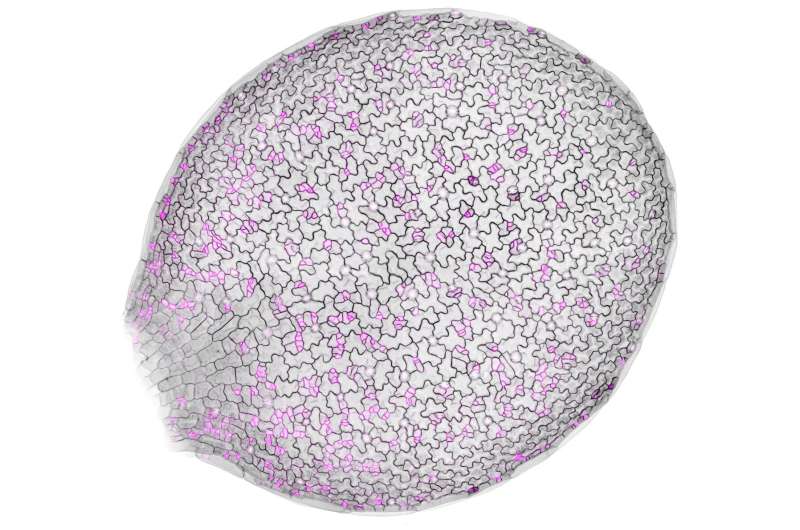New insight into how plant cells divide

Every time a stem cell divides, one daughter cell remains a stem cell while the other takes off on its own developmental journey. But both daughter cells require specific and different cellular materials to fulfill their destinies. Animal stem cells use the cytoskeleton—a transient network of structural tubules—to physically pull the correct materials from the parent cell into each daughter cell during the split. Plants also have stem cells that need to distribute different materials to each of their daughters, but earlier studies seem to have ruled out an “animal-style” cytoskeleton to accomplish this task. And what plants used instead remained elusive—until now.
In a new study published July 6 in Science, researchers at Stanford University found that plant cells also use the cytoskeleton. But there’s a twist. Instead of pulling on the cytoskeleton, like animal stem cells, the plant cells they studied actually pushed it away.
“Instead of using the cytoskeleton to say, ‘Divide this way!’ the plants said, ‘DON’T divide this way!’ ” said Andrew Muroyama, a former postdoctoral fellow at Stanford, currently an assistant professor at the University of California, San Diego, and the lead author of the paper.
The new finding could help researchers to engineer plants that are more adaptable to changing environments—a critical task as the world continues to face climate change.
“Understanding how stem cells divide in animals has been important for understanding various human diseases and has impacted translational medicines,” said Muroyama. “I have a similar hope that improving our understanding of how stem cells divide in plants might inform engineering applications in the future.”
Blocking wall construction by threatening catastrophe
Researchers in the lab of Dominique Bergmann, the Shirley R. and Leonard W. Ely, Jr. Professorship in the School of Humanities and Sciences professor of biology, began this work by investigating polarity complexes—little clusters of proteins that are critical in each cell to build leaves of the proper size and shape. Polarity complexes help dividing leaf stem cells orient themselves.
“Stem cells use these polarity proteins to decide where to divide,” said Muroyama. “We knew those proteins were involved in division, but we didn’t know how they controlled the process at the molecular level.”
To investigate how these proteins work, the team developed plant cell lines that expressed fluorescent versions of polarity complex and cytoskeletal proteins, then spent hundreds of hours in a dark room, tracking the glowing proteins’ movements while cells grew, divided, and repeated.
They soon observed that some cells weren’t dividing according to the “shortest wall rule,” which normally governs plant cell division. While plant cells are expected to build the smallest—and therefore most energetically conservative—walls possible to divide cells, in some cases, the polarity complex was located right where that wall would need to be built. Somehow, it blocked construction. Through a series of rigorous experiments, the researchers concluded that the polarity complex was pushing away the microtubules that would otherwise enable the construction of the wall.
“The polarity complex was like, ‘If any of you microtubules try to encroach on my region, I’m going to force you away. I’ll literally cause a catastrophe—that’s the technical term for completely disrupting microtubules—so you can’t invade this zone,’ ” said Bergmann.
Management for a changing climate
Bergmann’s lab is interested in resilience—how plants cope with changing environments. Plants survive by changing their leaves or their branch patterns, or the rates at which they respire or store sugars.
“This research could lead to applications where stem cell behavior could be tuned, for example, to alter plant architecture, or to help plants adjust to a changing climate,” said Muroyama.
Decisions about how to respond to signals from the environment are directed by stem cells. Within this process, Bergmann compares the polarity complex to a construction manager, giving the directions that ensure the stem cell splits properly.
“This construction manager receives signals from the environment, decides what to do, and tells the cell, ‘Yes, you should divide.’ But then it also says, ‘Now you’ve divided. Go off and seek your fortune,’ ” said Bergmann.
Now that the researchers know how this manager works, they can determine its role in upstream and downstream processes—and figure out ways to harness its power.
“Exactly how the polarity complex works is something we still need to figure out,” said Bergmann. “How do you get all these plants that make really cool specialized cells—cells that make interesting shapes, cells that make interesting chemicals, cells that respond to certain stimuli? And can we engineer that to happen?”
More information:
Andrew Muroyama et al, Cortical polarity ensures its own asymmetric inheritance in the stomatal lineage to pattern the leaf surface, Science (2023). DOI: 10.1126/science.add6162
Citation:
New insight into how plant cells divide (2023, July 6)
retrieved 6 July 2023
from https://phys.org/news/2023-07-insight-cells.html
This document is subject to copyright. Apart from any fair dealing for the purpose of private study or research, no
part may be reproduced without the written permission. The content is provided for information purposes only.
For all the latest Science News Click Here
For the latest news and updates, follow us on Google News.

